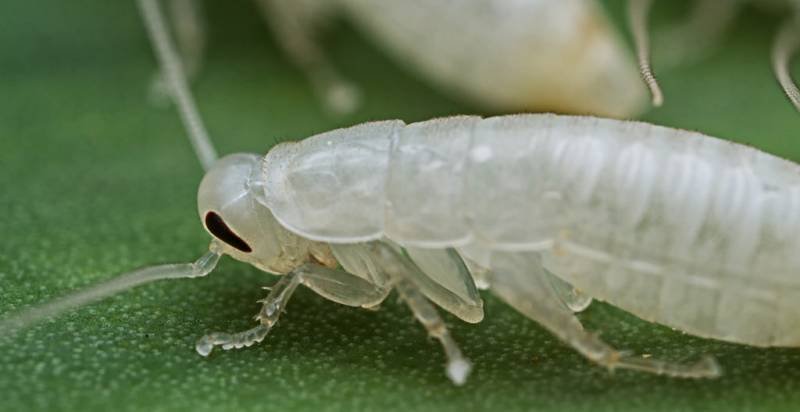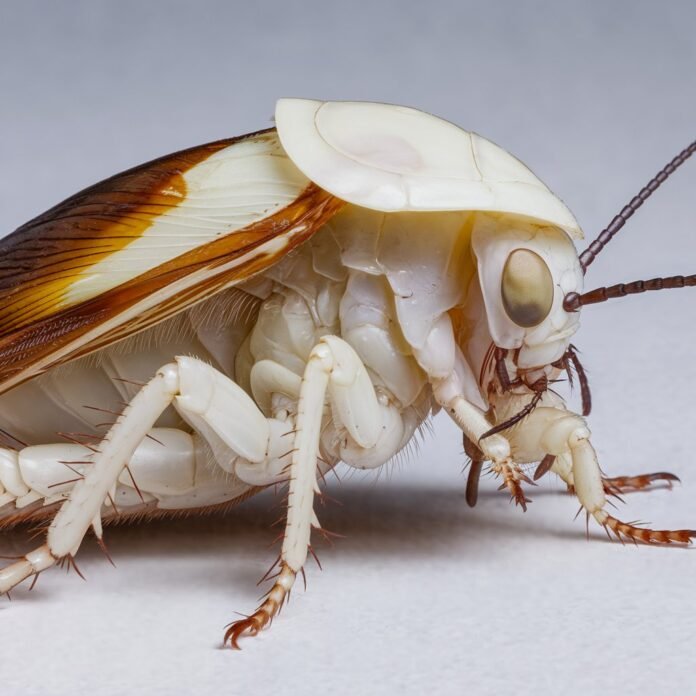Introduction
The term “white roach” often invokes curiosity and confusion. Many people mistakenly believe that these roaches are albino or rare, but in reality, they are simply common cockroaches that have recently molted. This article aims to provide an in-depth understanding of white roaches, debunk myths, and offer insights into their behavior, lifecycle, and how to manage their presence effectively. Whether you’ve encountered one of these pale insects in your home or are simply curious, this guide will provide you with all the information you need.
White roaches aren’t albino; they’re just regular cockroaches that have recently molted. Unlike albinos, which lack skin pigment, these roaches appear white temporarily until their new exoskeleton hardens and darkens.
What is a White Roach?
A white roach is not a different species but rather a typical cockroach that has shed its exoskeleton. Cockroaches molt several times throughout their lives, and after shedding their old exoskeleton, they appear white due to the softness and newness of their fresh skin. Over time, this skin hardens and darkens, turning into the brown or black color typically associated with cockroaches.
The Molting Process in Cockroaches
Molting is a natural process in which a cockroach sheds its old exoskeleton to grow. Here’s a breakdown of this fascinating process:
- Why Cockroaches Molt: Cockroaches molt as part of their growth process. As they grow, their exoskeleton becomes too tight, necessitating the shedding of the old shell to allow for a larger one.
- The Stages of Molting:
- Pre-Molt Stage: The cockroach prepares for molting by absorbing moisture and nutrients, which help in loosening the old exoskeleton.
- The Molt: The cockroach splits its old exoskeleton, usually along the back, and slowly wiggles out, leaving behind an empty shell.
- Post-Molt Stage: After molting, the cockroach appears white and soft. It takes several hours to days for its new exoskeleton to harden and darken.
- Frequency of Molting: Cockroaches typically molt 5-8 times before reaching adulthood. The frequency depends on the species and environmental conditions.
Misconceptions About White Roaches
There are several myths and misconceptions surrounding white roaches:
- Albino Cockroach Myth: Many people believe that white roaches are albino, but this is incorrect. Albino creatures lack pigmentation due to genetic factors, while white roaches are simply newly molted and will darken over time.
- Rarity of White Roaches: Some assume that white roaches are rare, but they are quite common in areas where cockroach infestations occur. The white appearance is just a temporary stage in the molting process.
- Health Risks: There is no evidence to suggest that white roaches carry more health risks than their darker counterparts. However, like all cockroaches, they can spread bacteria and allergens.
Common Species of Cockroaches That Molt to White
Several species of cockroaches can appear white after molting. Here are the most common ones:
- German Cockroach: The most common household pest, the German cockroach, frequently molts in residential environments.
- American Cockroach: Known for its large size, the American cockroach can also appear white after molting, especially in damp areas like basements and sewers.
- Oriental Cockroach: Less common but still present in many homes, the Oriental cockroach can also be seen in its white stage after molting.
- Brown-Banded Cockroach: This smaller species is known for its ability to live in drier environments, and like the others, it can appear white after molting.
The Life Cycle of a Cockroach
Understanding the life cycle of a cockroach is key to controlling infestations. Here’s a summary:
- Egg Stage: Female cockroaches lay eggs in cases called oothecae. Depending on the species, each case can contain anywhere from 10 to 50 eggs.
- Nymph Stage: Once hatched, cockroaches enter the nymph stage, where they will molt several times, appearing white after each molt. The nymphs gradually grow larger with each molt.
- Adult Stage: After the final molt, the cockroach reaches adulthood. At this stage, the exoskeleton is fully hardened and darkened.

Why You Might Find White Roaches in Your Home
There are several reasons why white roaches might be spotted in your home:
- Molting in Safe Spaces: Cockroaches seek safe environments to molt because they are more vulnerable during this time. These locations are often hidden, such as under appliances, in cracks and crevices, or in basements.
- Recent Infestation: A sudden sighting of white roaches may indicate a recent infestation, as nymphs are more likely to be seen after molting.
- Environmental Factors: Warm, humid environments can accelerate the molting process, making it more likely to spot a white roach.
Health Risks Associated with Cockroaches
While white roaches themselves do not pose additional risks, all cockroaches can carry health risks, including:
- Allergies and Asthma: Cockroach droppings, saliva, and shed skin can trigger allergies and asthma, especially in children.
- Disease Transmission: Cockroaches are known to carry bacteria, such as E. coli and Salmonella, which can contaminate food and surfaces.
- Bites: Though rare, cockroaches can bite humans, typically in cases of severe infestations.
How to Manage and Prevent White Roach Infestations
Managing cockroach infestations, including white roaches, requires a combination of prevention and treatment strategies:
- Identify the Infestation: Look for signs of cockroach activity, including droppings, shed skins, and the presence of white nymphs.
- Sanitation: Keep your home clean by eliminating food and water sources. Cockroaches thrive in environments with accessible food, so store food in sealed containers and promptly clean up spills.
- Seal Entry Points: Cockroaches can enter through cracks, gaps, and holes in walls, floors, and foundations. Sealing these entry points can help prevent infestations.
- Use Traps and Baits: Commercial cockroach traps and baits are effective in controlling populations. Place them in areas where cockroaches are likely to hide, such as under sinks and behind appliances.
- Chemical Treatments: In cases of severe infestations, professional pest control services may use chemical treatments to eliminate cockroaches. These treatments can target both adults and nymphs.
- Natural Remedies: For those who prefer non-chemical methods, natural remedies such as diatomaceous earth, boric acid, and essential oils like peppermint can be used to deter cockroaches.
The Role of Professional Pest Control
While DIY methods can be effective, professional pest control services offer several advantages:
- Comprehensive Inspection: Professionals can conduct a thorough inspection of your home to identify all potential hiding spots and entry points.
- Targeted Treatment: Pest control experts use targeted treatments that can reach areas where cockroaches hide, ensuring a more effective solution.
- Long-Term Prevention: Professional services often include follow-up visits and recommendations for long-term prevention, reducing the likelihood of future infestations.
Environmental Impact and Cockroach Control
It’s important to consider the environmental impact of cockroach control methods:
- Chemical Pesticides: While effective, chemical pesticides can have negative effects on the environment, particularly if used in large quantities.
- Eco-Friendly Options: Many pest control companies now offer eco-friendly options that minimize environmental impact, such as using natural predators or biological controls.
- Integrated Pest Management (IPM): IPM is a holistic approach that combines multiple control methods, including sanitation, physical barriers, and biological controls, to reduce the need for chemical pesticides.
The Evolutionary Success of Cockroaches
Cockroaches have been around for millions of years and are considered one of the most successful groups of insects. Here’s why:
- Adaptability: Cockroaches can survive in a wide range of environments, from tropical forests to urban settings.
- Resilience: They can endure extreme conditions, including radiation, dehydration, and starvation.
- Reproductive Capacity: Cockroaches reproduce quickly, with some species capable of producing hundreds of offspring in a single year.
FAQs About White Roaches
1. Are white roaches dangerous?
No, white roaches are not more dangerous than their darker counterparts. They are simply newly molted cockroaches and will darken over time.
2. How long do white roaches stay white?
White roaches typically remain white for several hours to a few days after molting, depending on environmental conditions.
3. Can white roaches indicate a large infestation?
Yes, spotting white roaches can be a sign of a larger infestation, as it indicates the presence of nymphs in various stages of growth.
4. How can I prevent white roaches in my home?
Maintaining cleanliness, sealing entry points, and using traps or professional pest control services can help prevent cockroach infestations.
5. What should I do if I find a white roach?
If you find a white roach, it’s important to take action to prevent a larger infestation. Consider setting traps, improving sanitation, and contacting a pest control professional if necessary.
Conclusion
White roaches are a common and natural part of the cockroach lifecycle. Understanding their molting process, behavior, and how to manage infestations can help you keep your home free of these pests. While they may seem unusual, white roaches are simply a temporary phase in the life of a cockroach and are not inherently more dangerous or rare than their darker counterparts. By following the tips and strategies outlined in this guide, you can effectively manage and prevent cockroach infestations, ensuring a healthier and more comfortable living environment.




